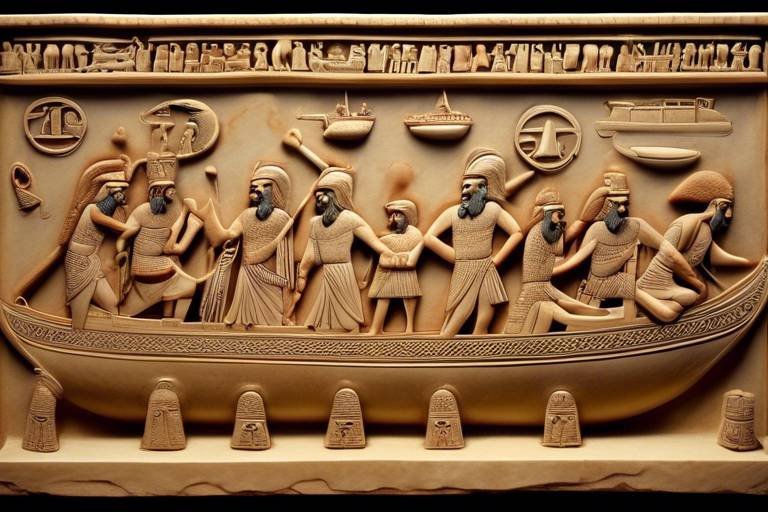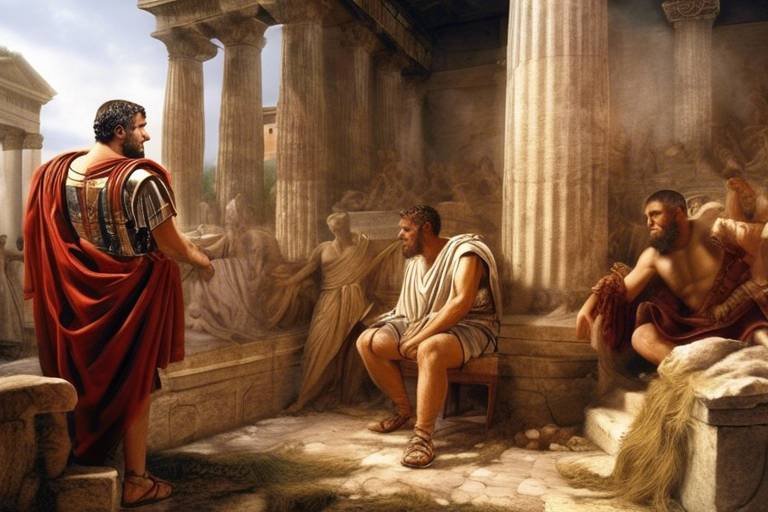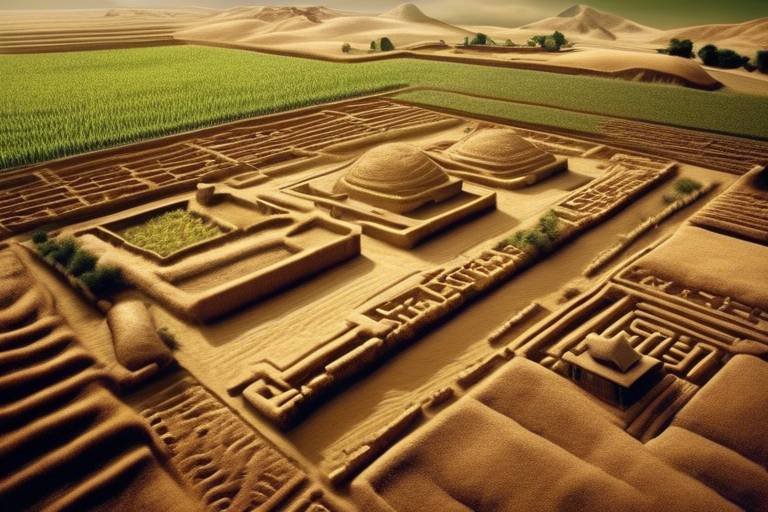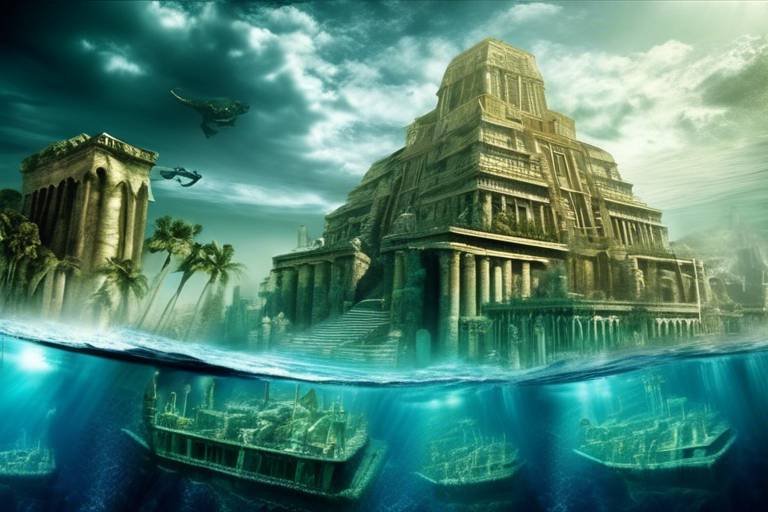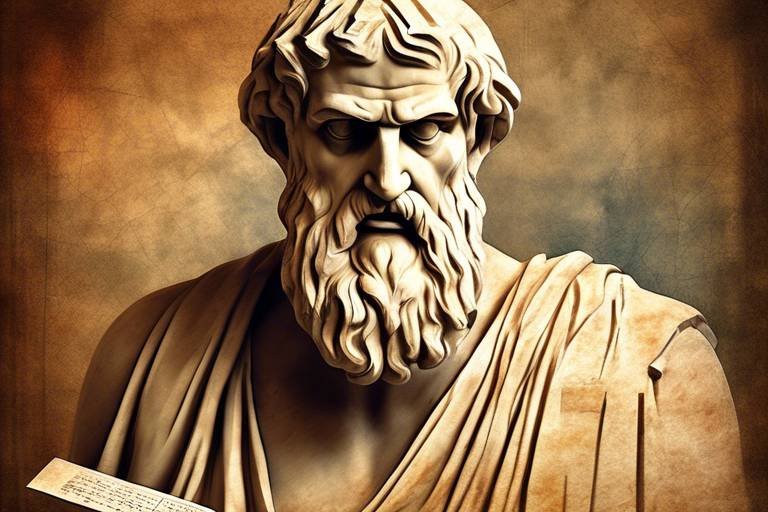The Enigma of the Ancient Romans' Innovations
The ancient Romans, often revered for their conquests and grandeur, left behind a legacy of innovation and ingenuity that continues to shape our world today. While their military prowess and architectural marvels are well-known, the lesser-known technological advancements and societal contributions of the Romans are equally fascinating and impactful.
One of the most remarkable feats of Roman engineering was the creation of aqueducts, which revolutionized urban planning and provided access to clean water for Roman cities. These impressive structures not only ensured the health and well-being of the population but also showcased the Romans' mastery of hydraulic engineering.
Another significant contribution of the ancient Romans was the development of an extensive network of roads that connected their vast empire. These well-constructed roads facilitated trade, communication, and military movements, laying the foundation for the efficient transportation systems we rely on today.
When it comes to architecture and engineering, the Romans were pioneers in constructing iconic structures like the Colosseum and the Pantheon. Their innovative building techniques and sophisticated designs continue to inspire architects and engineers around the world.
The Romans were not just skilled builders but also adept lawmakers. They established a sophisticated legal system that introduced concepts such as 'innocent until proven guilty,' which are fundamental principles of modern legal practices. The legacy of Roman law can be seen in legal systems across the globe.
Furthermore, the Roman military was renowned for its strategic prowess and innovative tactics. From the formation of legions to the use of siege weapons, their military innovations shaped warfare for centuries to come and influenced military strategies worldwide.
Language and literature were also areas where the Romans excelled. The Latin language, with its precision and elegance, became the foundation of many modern languages. Roman authors like Virgil and Cicero produced literary works that have stood the test of time and continue to influence Western literature.
Art and culture thrived in Roman society, with elaborate mosaics, intricate sculptures, and vibrant frescoes reflecting their values and aesthetics. These artistic expressions not only adorned their buildings but also served as a means of storytelling and cultural preservation.
Moreover, the Romans made significant advancements in medicine, implementing public health initiatives and surgical techniques that improved the well-being of their citizens. Their contributions to medical practices laid the groundwork for modern healthcare systems and continue to impact the field of medicine.

Aqueducts and Water Management
Exploring the lesser-known technological advancements and societal contributions of the ancient Romans that continue to influence modern civilization.
In ancient Rome, aqueducts were revolutionary engineering marvels that transformed urban planning and ensured access to clean water for the growing Roman cities. These sophisticated structures, often spanning long distances and varying terrains, utilized gravity to transport water from distant sources to populated areas, providing a reliable supply for public baths, fountains, and private homes.
The aqueduct system not only improved sanitation and hygiene but also facilitated agricultural irrigation, supporting the flourishing agricultural economy of the Roman Empire. The meticulous planning and precise construction of aqueducts showcased the Romans' ingenuity and mastery in hydraulic engineering, setting a benchmark for future civilizations.
By harnessing the power of gravity and incorporating innovative architectural techniques, the Romans created a network of aqueducts that stood as a testament to their advanced knowledge and dedication to improving the quality of life for their citizens.

Roman Roads and Transportation
Exploring the lesser-known technological advancements and societal contributions of the ancient Romans that continue to influence modern civilization.
In ancient Rome, the development of an extensive network of roads was a groundbreaking innovation that significantly impacted the empire's growth and connectivity. These well-engineered roads were not mere pathways but strategic arteries that facilitated trade, communication, and military conquests across the vast Roman Empire. The Romans understood the importance of efficient transportation for the expansion and stability of their empire, and thus, they invested heavily in constructing durable roads that connected distant regions.
These Roman roads were meticulously planned and constructed, utilizing advanced engineering techniques for durability and longevity. The system of roads enabled swift movement of troops, goods, and information, contributing to the economic prosperity and cultural exchange within the empire. The road network also played a crucial role in the rapid deployment of Roman legions during military campaigns, showcasing the strategic advantage of organized transportation infrastructure.
Moreover, the Roman roads were not only functional but also symbolized the empire's power and authority. They served as a physical manifestation of Roman engineering prowess and administrative efficiency, leaving a lasting legacy that influenced subsequent civilizations. The construction of roads reflected the Romans' commitment to innovation and progress, setting a standard for transportation infrastructure that would endure for centuries to come.
Furthermore, the Roman road system was a testament to the empire's meticulous planning and organizational skills. The roads were equipped with milestones, way stations, and bridges, ensuring smooth travel and efficient communication throughout the vast territories under Roman rule. This network of interconnected roads facilitated the movement of people and goods, fostering cultural exchange and economic development across different regions of the empire.
In essence, the Roman roads were not merely physical pathways but lifelines that connected the diverse corners of the empire, shaping its cultural, economic, and military landscape. The legacy of Roman transportation infrastructure continues to resonate in modern road systems and urban planning, underscoring the enduring impact of ancient Roman innovations on contemporary society.

Roman Architecture and Engineering
Exploring the lesser-known technological advancements and societal contributions of the ancient Romans that continue to influence modern civilization.
In the realm of architecture and engineering, the ancient Romans left an indelible mark that resonates through the ages. Their innovative construction techniques and grand architectural designs stand as a testament to their engineering prowess.
One of the most iconic examples of Roman architecture is the Colosseum, a marvel of ancient engineering that hosted gladiatorial contests and spectacles. Its massive amphitheater design, with intricate systems for crowd control and entertainment, showcases the Romans' mastery in creating monumental structures that have stood the test of time.
Furthermore, the Pantheon, with its remarkable dome and innovative use of concrete, exemplifies the Romans' architectural ingenuity. The precision in design and engineering required to construct such a monumental dome without modern technology is a testament to their skill and craftsmanship.
Not limited to grand monuments, Roman engineering also extended to aqueducts, bridges, and public baths. The aqueducts, in particular, highlight their expertise in water management and urban planning. These engineering marvels provided a reliable supply of fresh water to Roman cities, demonstrating their foresight in addressing essential infrastructure needs.
Moreover, the Romans' use of arches and vaults revolutionized architectural construction, allowing for the creation of expansive interior spaces and durable structures. Their architectural innovations laid the foundation for future developments in building design and construction techniques.
In essence, Roman architecture and engineering not only shaped the physical landscape of ancient Rome but also influenced architectural styles and engineering practices for generations to come.

Roman Legal System and Governance
The Roman legal system and governance were pivotal in shaping the foundations of modern legal practices. The Romans introduced groundbreaking concepts that continue to influence legal systems worldwide. One of the most significant contributions was the principle of innocent until proven guilty, a cornerstone of justice that ensures individuals are considered innocent unless proven otherwise. This concept revolutionized the approach to legal proceedings and laid the groundwork for fair trials and justice.
In addition to the presumption of innocence, the Romans also established a complex legal framework that encompassed various aspects of governance and civil life. The Roman legal system was characterized by its emphasis on written laws, legal procedures, and the role of judges in interpreting and applying the law. This structured approach to law paved the way for consistency and predictability in legal matters, ensuring a level of stability in Roman society.
Furthermore, the Roman governance system was marked by its hierarchical structure and division of powers. The Senate played a crucial role in decision-making and legislation, representing the interests of the Roman elite and providing a forum for political debate. The emperors, as the ultimate authority, wielded significant power but were also bound by legal constraints and traditions that governed their actions.
Moreover, the Romans developed sophisticated mechanisms for dispute resolution and conflict management, including the establishment of courts and legal procedures to address civil and criminal matters. The presence of magistrates and legal experts ensured the proper administration of justice and the protection of individual rights within the Roman legal system.
Overall, the Roman legal system and governance structures were instrumental in fostering a sense of order, justice, and accountability in ancient Roman society. Their enduring legacy continues to shape modern legal principles and institutions, highlighting the enduring impact of Roman innovations on the development of legal systems worldwide.

Roman Military Tactics and Innovations
Exploring the lesser-known technological advancements and societal contributions of the ancient Romans that continue to influence modern civilization.
The Roman military was renowned for its strategic prowess and innovative warfare techniques that shaped the course of history. One of the key innovations of the Roman army was the formation of the legion, a highly organized and disciplined military unit consisting of infantry and cavalry. This formation allowed for flexible tactics and coordinated maneuvers on the battlefield, giving the Romans a significant advantage over their enemies.
Another groundbreaking development was the construction of fortified camps (castrum) during military campaigns. These camps provided protection and logistical support for the troops, enabling them to operate efficiently in enemy territories. The strategic placement of these camps played a crucial role in ensuring the success of Roman military campaigns.
Furthermore, the Romans revolutionized siege warfare with the invention of advanced siege engines like ballistae and onagers. These powerful machines were used to breach enemy fortifications and launch projectiles, changing the dynamics of siege warfare and enhancing the Romans' ability to conquer fortified cities.
In addition to their technological innovations, the Romans excelled in strategic planning and adaptation on the battlefield. They were adept at utilizing terrain to their advantage, devising tactics that exploited enemy weaknesses and maximizing their own strengths. The flexibility and ingenuity displayed by Roman commanders in adapting to different combat scenarios were instrumental in their military successes.
Moreover, the Roman military's emphasis on training and discipline set them apart from their adversaries. Soldiers underwent rigorous training regimens and drills to ensure they were prepared for the rigors of battle. This focus on discipline and cohesion within the ranks contributed to the effectiveness of Roman military tactics and formations.
Overall, the Roman military's innovative tactics and strategic mindset not only secured the vast territories of the Roman Empire but also left a lasting legacy in the annals of military history, influencing warfare for centuries to come.

Roman Language and Literature
The Roman civilization not only left a remarkable legacy in terms of engineering and governance but also made significant contributions to language and literature. The Latin language, spoken by the ancient Romans, served as the foundation for many modern languages, including English, French, Italian, Spanish, and Portuguese. Its influence can be seen in legal terminology, scientific nomenclature, and everyday vocabulary, showcasing the enduring impact of Roman linguistic innovations.
Moreover, Roman literature flourished during the Republic and Empire periods, producing renowned authors like Virgil, Cicero, and Ovid. These literary giants crafted epic poems, philosophical treatises, and oratorical masterpieces that continue to be studied and admired today. Their works delve into themes of love, power, morality, and the human experience, offering insights into the values and beliefs of ancient Roman society.
The Roman penchant for storytelling and rhetoric also influenced the development of Western literary traditions. The art of persuasion, cultivated through public speeches and written discourse, became a hallmark of Roman communication. This emphasis on eloquence and argumentation laid the groundwork for future literary movements and rhetorical strategies, shaping the way in which ideas are conveyed and debated in the modern world.

Roman Art and Culture
Roman art and culture stand as a testament to the creativity and sophistication of ancient Roman society. The Romans excelled in various artistic forms, leaving behind a rich legacy that continues to inspire and captivate audiences worldwide. From intricate mosaics to imposing sculptures and vibrant frescoes, Roman artistry reflected the values and beliefs of the civilization.
One of the defining features of Roman art was its ability to blend influences from different cultures, incorporating elements from Greek, Etruscan, and Egyptian traditions. This fusion of styles resulted in unique and innovative artistic expressions that set Roman art apart from its predecessors.
The Romans were masters of architectural design, evident in the grand structures like the Colosseum, the Pantheon, and the Forum. These monumental buildings not only showcased the engineering prowess of the Romans but also served as symbols of power and grandeur, leaving a lasting impact on architectural styles for centuries to come.
Additionally, Roman art often depicted scenes from mythology, history, and everyday life, providing insights into the cultural practices and beliefs of the time. Mosaics adorned floors and walls, telling stories through intricate patterns and vibrant colors, while sculptures captured the beauty and realism of the human form with remarkable detail.
Furthermore, Roman culture was deeply intertwined with art, with public spaces adorned with statues, monuments, and decorative elements that reflected the values and ideals of the society. The art of the Romans not only served decorative purposes but also conveyed messages of power, prestige, and cultural identity.
Overall, Roman art and culture represent a vibrant tapestry of creativity, innovation, and expression that continues to fascinate and inspire audiences around the world. The legacy of Roman artistic achievements serves as a reminder of the enduring impact of ancient civilizations on contemporary society.

Roman Innovations in Medicine
Roman innovations in medicine during ancient times were remarkably advanced for their era, laying the groundwork for many medical practices still in use today. The Romans made significant contributions to public health and surgical techniques, enhancing the well-being of their citizens and influencing medical practices beyond their empire.
One of the key advancements in Roman medicine was the establishment of public health initiatives. The Romans understood the importance of sanitation and hygiene in preventing diseases. They built elaborate public baths, sewage systems, and aqueducts to ensure clean water supply, promoting better health among the population.
Furthermore, Roman physicians developed surgical techniques that were ahead of their time. They performed various surgeries, including amputations, cataract removals, and even brain surgeries. The use of surgical instruments like scalpels and forceps showcased their expertise in medical procedures.
In addition to surgical innovations, the Romans also excelled in pharmacology. They cultivated medicinal herbs and plants, creating remedies for various ailments. Roman pharmacists prepared ointments, poultices, and potions to treat illnesses and injuries, demonstrating their knowledge of herbal medicine.
The Roman military played a significant role in advancing medical practices as well. Military physicians known as "medici" provided medical care to soldiers on the battlefield, treating wounds and illnesses with skill and efficiency. Their experience in dealing with injuries sustained in combat contributed to the development of trauma care.
Overall, Roman innovations in medicine were diverse and influential, shaping the foundations of modern healthcare practices. Their emphasis on public health, surgical techniques, pharmacology, and military medicine left a lasting legacy that continues to impact the field of medicine today.
Frequently Asked Questions
- What were some key innovations in Roman architecture?
Roman architecture was characterized by monumental structures such as the Colosseum, Pantheon, and aqueducts. These showcase the Romans' mastery in construction techniques and architectural design, influencing architectural styles for centuries.
- How did Roman roads impact trade and communication?
The extensive network of Roman roads facilitated efficient trade, communication, and military movements throughout the empire. This infrastructure played a crucial role in the expansion and cohesion of the Roman Empire.
- What contributions did the Roman legal system make to modern practices?
The Roman legal system introduced concepts like innocent until proven guilty and the right to a fair trial. These principles laid the foundation for modern legal practices and the development of justice systems around the world.
- What were some notable advancements in Roman medicine?
Roman innovations in medicine included public health initiatives, surgical techniques, and the establishment of hospitals. These advancements improved the well-being of Roman citizens and contributed to the development of medical practices.
- How did Roman art reflect societal values and preferences?
Roman art, including mosaics, sculptures, and frescoes, depicted scenes from daily life, mythology, and historical events. These artworks reflected Roman societal values, aesthetics, and cultural beliefs.






